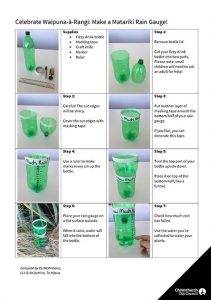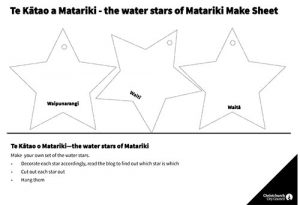Within the star cluster of Matariki there are three stars who are associated with water and all that rely on it. Waipunarangi / Waipunārangi – associated with the rain, Waitī – associated with freshwater and Waitā – associated with seawater. They are all linked to each other through the water cycle, where rain falls into the freshwater streams, which flows into the seawater, which evaporates into clouds which produces rain and so the cycle goes on.
The Importance of Water
Water is integral to life on earth and Te Kātao a Matariki – the water stars of Matariki are a reminder of the large role it plays in our ecosystem.
When Waipunārangi was seen in the sky at the rising of Matariki, a person knowledgeable in the stars would forecast the state of the weather associated with rain for the coming year. The rainfall had an impact on the crops being grown so was paid close attention to because it would determine the quality of the harvest.
The rainfall would also contribute fresh water to streams and lakes which flowed down into rivers and estuaries. These fresh water areas are the domain of Waitī including mahinga kai and ecological systems. As mahinga kai for tuna (eels), īnanga (whitebait), waikōura (freshwater crayfish), kōkopu (banded kōkopu), meant that the health of these areas was really important in sustaining the life that inhabited it.
Water is also important in ensuring the health of the plants and vegetation living alongside the waterways providing both shelter and food. Flowing downstream we eventually reach the moana (sea) which is associated with Waitā. All the sea life such as ika (fish), tio (oysters), kuku (green-lipped mussel), kina (sea urchin), pāua (abalone), as well as coastal environments like beaches, rock pools and reefs are guided by the rising of this star.
 Water travels a long way and it goes through many different environments providing life to many different creatures, including people. Its health is very important so we need to be good kaitiaki (guardians) and be mindful of how we can manaaki (take care of) our waterways. Read an excerpt of the book Mountains to Sea: Solving New Zealand’s Fresh Water Crisis, about the whakapapa (genealogy) of water and a Māori perspective on the freshwater debate.
Water travels a long way and it goes through many different environments providing life to many different creatures, including people. Its health is very important so we need to be good kaitiaki (guardians) and be mindful of how we can manaaki (take care of) our waterways. Read an excerpt of the book Mountains to Sea: Solving New Zealand’s Fresh Water Crisis, about the whakapapa (genealogy) of water and a Māori perspective on the freshwater debate.
Water Pollution
Water is the essence of all life and waiora (environmental well-being) but as our population grows and the demand on our natural environments increases, our waterways are in more and more danger. Water pollution is a big issue for our ecosystem and it’s a reality that we face here in Aotearoa. We have some of the most pure water in the world, a taonga of our country and the iwi connected to them, however this is being compromised due to the pollution of waterways.
Through Te Tiriti o Waitangi Settlement Claims Act for Ngāi Tahu, they have rangatiratanga (the right to exercise authority) over the fresh water in their takiwā (district) and it is consequently the property and taonga of Ngāi Tahu. To fulfil their responsibility to restore and maintain the water to a healthy state for the benefit of everyone, Ngāi Tahu have implemented a fresh water strategy.
Read Ka hao te Rakatahi Wai ora – we need to do better! written by a year 13 student at Christ’s College.
Water Projects
Our fresh water is at risk of being at the point of no return and it can be seen in our dry riverbeds, our lack of mahinga kai and our water pollution. Added to the current stressors is climate change – creating higher instream temperatures and periods of drought. Despite this we have many projects by many different people, organisations and iwi that are striving to keep our waterways clean and healthy for future generations.
- Whakaora Te Waihora (Lake Ellesmere) is a long-term project to fund the clean-up of fourth largest lake in Aotearoa.
- Te Mana o Te Wai: The Health of our wai, the health of our nation: Kāhui Wai Māori report which sets out recommendations for our nation to transition to a new system of care and respect for water.
- Marine Reserves and Marine Protected areas are managed by The Department of Conservation and are integral to the protection of our marine environments.
-
Te Awa Tupua (Whanganui River Claim) Bill was a historic bill that protects the Whanganui River with legal personhood and recognises the importance of the river to iwi. Since this bill passed, there have been many other bodies of water in Aotearoa and around the world granted legal personhood such as:
- The Waikato River
- The Ganges and Yamuna Rivers in India
- Lake Erie in Ohio, United States of America
- In Bangladesh ALL rivers
- Atrato River Basin in Colombia
- Vilcabamba River in Ecuador
Activities
Because we think water is awesome and really important, we have a cool water collection project that you can do at home.
Download Matariki rain gauge instructions [259KB PDF]
For further reading
- Take a look at our Matariki page for more information about the Māori New Year.
- Find more activities and information for tamariki on our Matariki for kids page.
- Check out our Ngā Whāinga – Challenges on mahinga kai to learn more about traditional food and other natural resources.
Māia Abraham
Pou Kohikohinga Māori | Māori Collections Specialist
Māori Services





Add a comment to: Te Kātao a Matariki – the water stars of Matariki